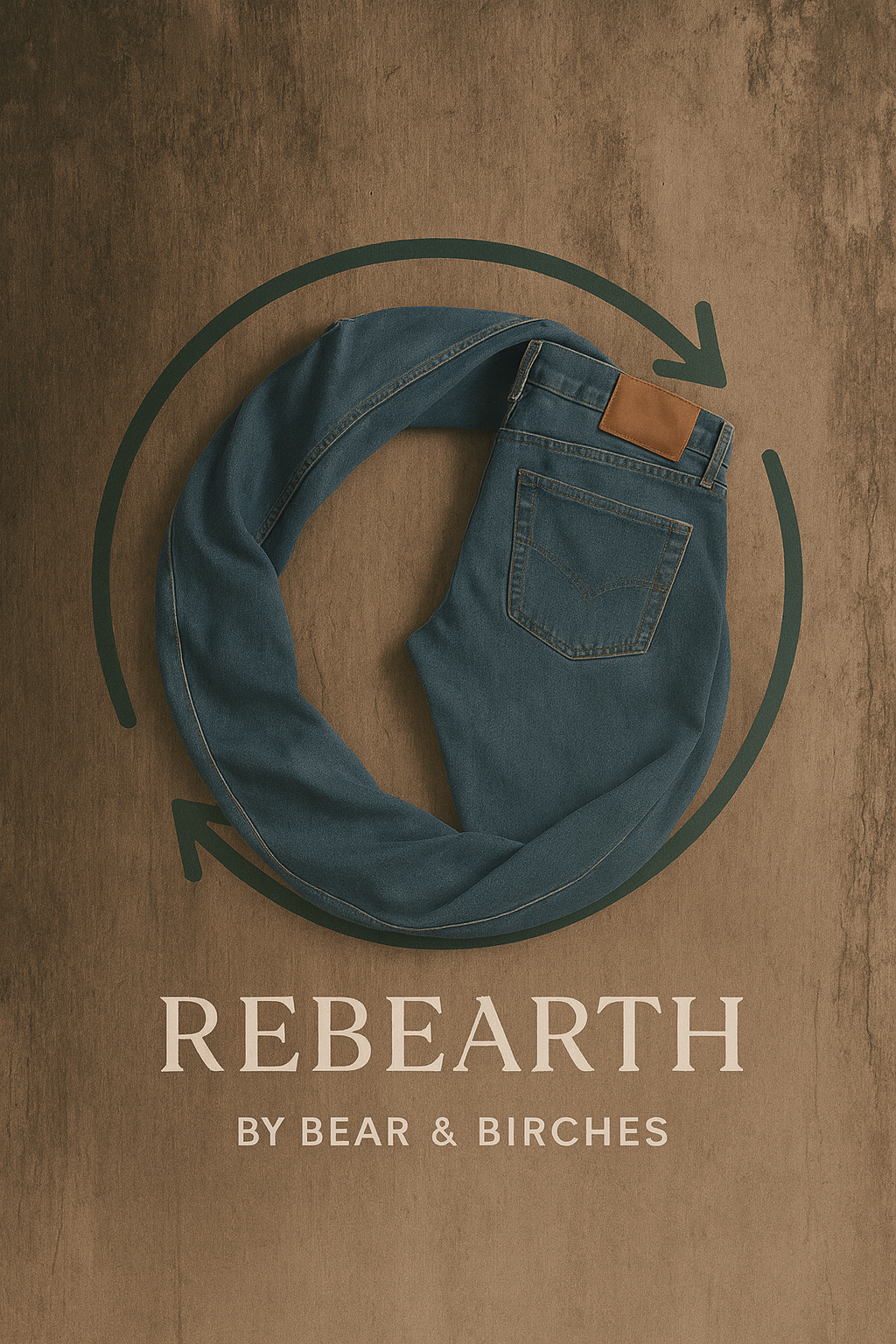When you drop mail in your old jeans to Bear & Birches, which is our recycling or take-back program, you might wonder what do we do?
Our primary objective is to contribute and continue to enhance our contribution through recycling, and in that regards, your jeans can become part of a circular denim economy that reduces waste, conserves water and carbon, and shifts the fashion industry away from “take-make-dispose.”
In this guide, we’ll walk you step-by-step through what happens after you send us your jeans, what impact that has on resources, climate, and waste, and how ReBearth by Bear & Birches is aiming to partner with this system.
Why Recycling Jeans Matters (Beyond Feel-Good)
The Footprint We Leave
A single pair of conventional denim jeans is responsible for ~ 33.4 kg CO₂e across its lifecycle (materials, production, transport). That same pair consumes ~ 3,781 liters of water and requires ~ 12 m² of land use. Globally, textile waste is surging: 92 million tons per year in apparel and textiles. Less than 15% of U.S. textile waste is recycled or reused; the rest ends up incinerated or in landfills.
According to Environmental Investigation Agency (EIA), the fashion & textile industry accounts for 8–10% of global greenhouse gas emissions, outpacing aviation & shipping combined. These figures show: returning your jeans isn’t a small gesture — it’s an action against one of the fastest-growing waste streams in the world.
The Value of Reuse over Recycling
A lifecycle assessment by EuRIC shows that reusing a garment has up to 70× lower environmental impact (in CO₂ and water) than making a new one, even considering transport. However, when the garment is beyond reuse, recycling may still offer environmental benefits vs. landfill or incineration. The key is maximizing use first, then recycling, then disposal.
From Drop-Off to Rebearth: The Journey of a Recycled Pair
Let’s trace the path your jeans would typically take after you return them.
As a first step, any vendor collecting your denim, will have to not only create a mechanism for collection but also sorting. In the case of a mail-in jeans by-back programs, we will be responsible for categorizing them. Typically, we will invest resources in categorizing them by fiber type (cotton, cotton blends, synthetics). Since technology is improving, it is expected that not only Bear & Birches but other vendors collecting denim we will be able to employ advance AI spectral imaging to classify more accurately, thereby improving recycling yields.
Pre-Processing & Cleaning
Ideally, it is expected that a recycler – when it gets the garments - will invest further financial and other resources to clean remove stains, embellishments, zippers, buttons, etc. One of the major concerns that recycler facilities face is that of contamination which reduces recycling efficiency. As per the American Chemical Society’s (ACS) Sustainable Textiles report, textile recycling is sensitive to contamination: even 10–15% non-cellulosic fiber content can complicate recycling.
Fiber Recovery / Reforming
Following this, there are two primary routes: One, Mechanical recycling: shredding cotton/denim into shorter fibers, which can be spun into new yarn. Two, chemical (or “dissolving”) recycling: converting cotton (or cellulosic fibers) back to a pulp or monomer form to re-spool higher-quality fiber.While the second option is cleaner, it but more energy- and chemical-intensive, since it a repeated cycles degrade fiber quality. The European Commission warns that one-third of textile waste is multi-fiber (e.g. blends), making pure recycling harder.
A brand like Recover (Spain) publishes a Life Cycle Assessment showing that recycled cotton bypasses stages like farming, ginning, and some dyeing, which yields measurable environmental savings.
Re-Spinning, Dyeing, & Manufacturing
Once new yarns are created, they may be re-dyed, woven, and finished (washed, treated) into new denim fabric. Each step still uses energy, water, and chemicals (though often less than virgin production). There are only a handful of brands embrace “circular denim” models, designing denim that is easier to disassemble and recycle.
Key Impacts & Trade-Offs
Water & Chemical Reduction
Because recycled cotton bypasses aspects of cultivation and processing, water use and chemical discharge can drop. For instance, wastewater loading from indigo dyeing—a known pollutant—is lessened when reusing materials. However, chemical recycling processes must manage effluents carefully to avoid new water pollution.
Carbon & Energy Savings
It is noteworthy that each recycling loop avoids emissions from virgin fiber production, manufacturing, and transportation. That said, the energy used in recycling (especially chemical) must be from clean sources to maximize benefit.
Material Degradation & Quality Loss
Also, fiber length degrades with mechanical recycling, limiting how many times a material can be recycled while maintaining durability. Thus, recycled fibers are often blended with virgin fibers to regain strength.
Designing for Circularity
At ReBearth by Bear & Birches, we aim to embed circularity as a starting point of our effort to contribute to a more responsible world that seeks to arrest the degrdarion that fast fashion has caused. As a starting point we will be using TerraCycle’s recycling mechanism until we receive sufficient denim back into our system to create a verified recycling systems of our own. We have big plans and bug ideas. Therefore, when you buy a Bear & Birches denim, the end-of-life path is part of the product plan.
Implementing Take-Back / Recycling Programs
We encourage customers to return jeans after use — either your own or any brand — into our Rebearth program. Once collected, we will channel them into trusted recycling partners, track and verify outcomes (how much was reused vs recycled) and we are committed to sharing and publishing that information to our customers and the world at large in our Responsibility Journal. We hope that in shortest possible time, we will be able to explain to consumers the impact (carbon, water) of returning jeans, as well as our annual recycling metrics publicly.




Leave a comment
All comments are moderated before being published.
This site is protected by hCaptcha and the hCaptcha Privacy Policy and Terms of Service apply.